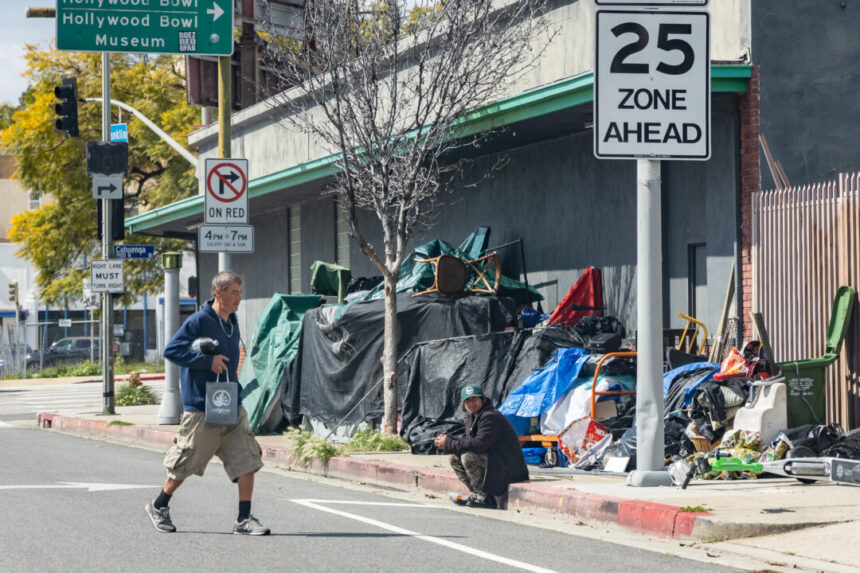Encampments on state property that pose an imminent threat to public safety will be removed. At other camps, a notice to vacate will be posted.
Following a Supreme Court ruling in June granting local governments the authority to enforce laws related to illegal camping and homelessness, California Governor Gavin Newsom issued an executive order on July 25 instructing state departments and agencies to begin clearing encampments.
“This executive order directs state agencies to promptly address dangerous encampments while supporting and assisting the individuals living in them—and provides guidance for cities and counties to do the same,” Governor Newsom stated in a release accompanying the order.
Although he cannot compel local governments to act within their jurisdictions, he encouraged officials to implement policies that allow for the removal of homeless camps to safeguard public safety.
“There are no longer any excuses,” Governor Newsom emphasized. “It’s time for everyone to play their part.”
The executive order acknowledged the impact of legal challenges and injunctions that had hindered local officials from clearing encampments in the past, leaving them without the necessary tools or guidance to address the crisis on their streets.
The Ninth U.S. Circuit Court of Appeals decision in the Grants Pass case, issued in September 2022, had barred local governments from clearing encampments and enforcing their laws, citing potential “cruel and unusual punishment” if sufficient shelter space was unavailable.
However, the Supreme Court’s 6–3 ruling on June 28 overturned this decision.
“While well-intentioned … answers to questions such as what constitutes ‘involuntarily’ homelessness or when a shelter is ‘practically available’ cannot be derived from the cruel and unusual punishments clause of the U.S. Constitution,” wrote Supreme Court Justice Neil Gorsuch in the majority opinion. “Nor do federal judges possess any special expertise to provide such answers.”
With the legal barriers now removed, the governor has directed agencies and departments under his jurisdiction to immediately begin clearing encampments from state property.
Officials have been instructed to adhere to the guidelines outlined in the California Department of Transportation’s Maintenance Policy Directive, collaborating with local agencies while giving priority to clearing encampments.
Site assessments will determine if encampments pose imminent threats—such as those to “life, health, safety, or infrastructure”—and if any are identified, the encampments must be cleared without delay.
For encampments where no immediate threats are found, officials are mandated to post a notice to vacate sites at least 48 hours before conducting sweeps.
Outreach services will be provided to individuals residing in the camps.
Officials will collect, label, and store personal items cleared from the encampments for a minimum of 60 days.
Departments and agencies not under the governor’s direct purview are urged to adhere to similar guidelines.
Similarly, local governments are “encouraged” to adopt these policies and utilize available resources and infrastructure “to act with the urgency necessary to humanely clear encampments from public spaces,” as stated in the executive order.
San Francisco recently announced plans to establish new protocols for clearing encampments, while other cities like Los Angeles have expressed reluctance to do so. The response of cities and counties to the governor’s directives remains uncertain.
The California Interagency Council on Homelessness will supervise the implementation of policies in alignment with the executive order.
Governor Newsom highlighted the necessity of the new directive due to the escalating homelessness crisis in the state in recent years—with over 180,000 individuals affected, including 123,000 living unsheltered on the streets in tents, vehicles, and trailers.
According to the executive order, this poses risks to homeless individuals, exposing them to “extreme weather, fires, predatory and criminal activity, and widespread substance abuse, jeopardizing their health, safety, and well-being.”
The governor reiterated his commitment to eradicating homelessness since the inception of his administration. In 2020, he issued an executive order directing departments to identify strategies for utilizing resources to establish short-term shelters.
Since July 2021, the California Department of Transportation has cleared 11,188 encampments on state property and removed 248,275 cubic yards of debris from these sites, as per the recently released order.
During Governor Newsom’s tenure, California has allocated over $24 billion toward addressing homelessness—including nearly $5 billion in Homeless Housing, Assistance, and Prevention grants; $1 billion in encampment resolution funding; and $3.3 billion for housing individuals in hotels and other locations through the state’s Homekey program.
In a bid to enhance accountability, the governor and the Legislature passed the 2024–2025 budget with trailer bills that mandate increased metrics and reporting to enable officials to track expenditures and assess the efficacy of programs.
The order asserts that the new guidelines prioritizing shelter and services are a crucial step toward clearing encampments while upholding the “dignity of every Californian and offering meaningful pathways to end homelessness.”
Can you rephrase this sentence?
Source link





